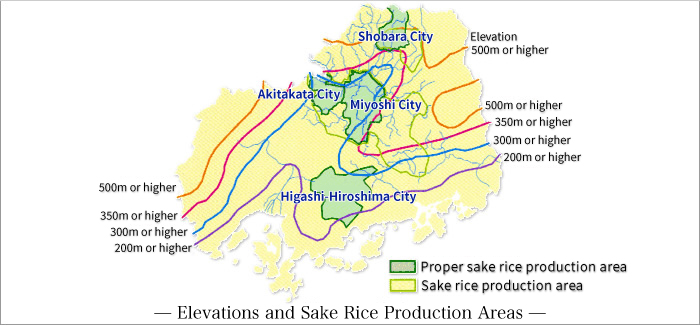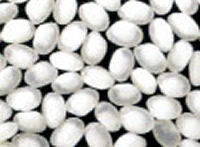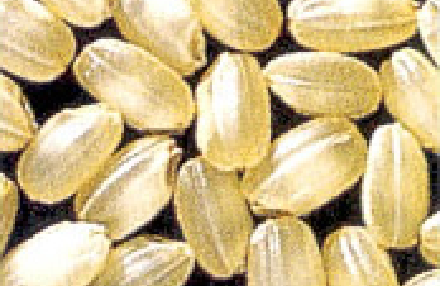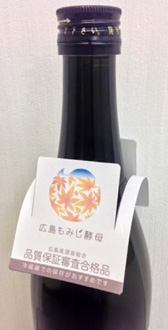Sake Brewing in Hiroshima
Sake Brewing in Hiroshima, One of Japan’s Most Famous Brewing Areas
Technology, climate, rice, and water… These four conditions coincide perfectly to produce delicious Hiroshima sake.
In Hiroshima Prefecture, four organizations––the Prefectural Agricultural Technology Center, the Prefectural Food Technology Research Center, JA Group Hiroshima, and the Sake Brewers Association––maintain close cooperation, and brands of proper sake rice (Hattan-Nishiki, Senbon-Nishiki, etc.) and yeast that are independently developed and successfully produced by the prefecture receive high acclaim year after year, winning gold prizes at the Japan Sake Awards.
Nationally Renowned Hiroshima Toji

The actual brewing of sake is handled by chief brewers titled toji.
Toji in Hiroshima have long been known for their traditional Hiroshima-style techniques. They display their skills at breweries throughout Japan, and have played central yet often unnoticed roles in popularizing Hiroshima sake throughout the country.
Hiroshima was one of the first prefectures to organize a Toji Guild Association, which has been holding annual seminars and other events since 1905, greatly contributing to the modernization of sake production in Japan. Toji also exchange knowledge and information with each other about how to breathe life into the rice and water they use. Through this, they are able to nurture sake in Hiroshima and take on the challenge of creating new types of high-quality sake that meet the needs of the times.

The Climate in Hiroshima is Considered a Microcosm of Japan
Hiroshima Prefecture faces the Seto Inland Sea in the south and is capped by the Chugoku Mountains in the north. The difference in temperature between the warmer areas and the regions with heavy snowfall on par with the western coast of Japan is so great that the prefecture truly looks like a microcosm of Japan. This is why even sake produced within Hiroshima can have such a wide variety of flavors, from sweet to dry and from light to rich. Sake breweries throughout the prefecture produce unique types of sake.
The best areas for growing proper sake rice are located in semi-mountainous areas at elevations of 200 to 400 meters that are blessed with granitic soil and experience large temperature variations throughout the day during the time of year when the rice is ripening. In Hiroshima Prefecture, it is produced in sake rice production complexes in Higashi-Hiroshima City, Miyoshi City, Akitakata City, and Shobara City.

Click here for introductions of each sake rice complex
Nationally Acclaimed Proper Sake Rice

The rice used to make sake is the deciding factor in its taste and quality. Toji (chief brewers) say that they decide what kind of sake to make based on the variety of sake rice. For a long time, many people have worked to improve the quality and cultivation techniques of rice in search of “proper sake rice,” which is highly suited to sake brewing.
There are six varieties of rice grown in Hiroshima Prefecture, along with three strains: Omachi, Hattan, and Yamada-Nishiki. These are highly rated by sake breweries throughout the country for meeting a diverse range of customer needs.
The varieties of rice produced in Hiroshima Prefecture that are considered to be of particularly high quality include Kairyo-Omachi and Hattan-Nishiki. Hattan and Kairyo-Omachi have long been the main varieties of rice grown in Hiroshima Prefecture. Later, improvements in quality led to the creation of Hattan-Nishiki (which produces a highly fragrant, light flavor) and Hiroshima-Hattan (which symbolizes the type of sake preferred by women with its lustrous aroma) within the Hattan strain, as well as Hiroshima-Omachi (with a rich, deep flavor) and Koi-Omachi (characterized by its ginjo aroma and full-bodied flavor) within the Omachi strain.
| Strains | Varieties | Characteristics |
|---|---|---|
| Omachi | Kairyo-Omachi, Koi-Omachi | This sake is likened to a glamorous, plump, beautiful woman. |
| Hattan | Hattan, Hattan-Nishiki | This sake is likened to a modern, elegant, beautiful woman. |
| Yamada-Nishiki | Yamada-Nishiki, Senbon-Nishiki | This light, dry sake is likened to tall, slender, beautiful woman. |

Koi-Omachi brown rice

Hattan-Nishiki brown rice
Soft water that springs from the Chugoku Mountains
The clear water that springs from between the granite rocks of the Chugoku Mountains is delicious enough to drink as it is. It is this water that forms the basis of Hiroshima sake. Hiroshima toji (chief brewers) brew sake in brewing areas throughout the prefecture, taking advantage of the Hiroshima-style soft water brewing method.
Revolutionizing Hiroshima Sake by Making the Most of Soft Water––Previously Thought Unsuitable for Sake Brewing
Click here to read the historical story of Miura Senzaburo.
Hiroshima Yeast
The sake industry can be considered to be in the midst of a ‘yeast war,’ as it is the yeast that determines whether the sake will have a unique flavor or not. Hiroshima Prefecture as well has been cultivating Hiroshima Yeast No. 2, 5, 6, and 21, Setouchi No. 21, and Reiwa No. 1 Yeast at the Prefectural Food Technology Research Center, and further research on new varieties of yeast is underway.
The reason that Hiroshima sake is so delicious is not only due to the excellent skills of the toji but also largely to the fact that the prefecture is greatly blessed with proper sake rice and yeast.
Yeast Name
In consultation with the Hiroshima Prefecture Sake Brewers Association, this variety was named “Hiroshima Momiji Yeast,” and it was unveiled at the association’s general meeting in October 2013.

As the official tree and flower of Hiroshima Prefecture, momiji (Japanese maple) trees are a familiar and indispensable part of Hiroshima’s climate.
The logo represents an adult woman enjoying sake and the smooth, fruity characteristics of the new yeast.
The symbol, modeled after a sphere of yeast, represents momiji leaves (the yeast) at the bottom transforming into sake sloshing around at the top.
Establishment of a Quality Assurance Review System
A quality assurance system for sake produced using Hiroshima Momiji Yeast has been established to serve as a visual aid for consumers when selecting smooth, light, and fruity sake.
Review Targets
Limited to sake with a specified name made solely using Hiroshima Momiji Yeast and made commercially available after bottling.
Judges
Sensory evaluators from the Hiroshima Regional Taxation Bureau, the National Research Institute of Brewing, brewing companies that belong to the Hiroshima Prefecture Sake Brewers Association, and our Center
Review Criteria
Is it smooth, light and fruity? Does it meet or exceed a certain level of quality?

Sake that meets the criteria is granted permission to use the logo.
As of July 2014, 23 products (14 companies) have passed the review.


